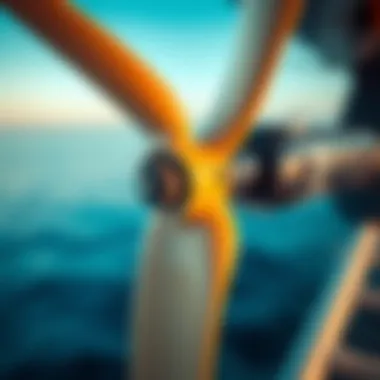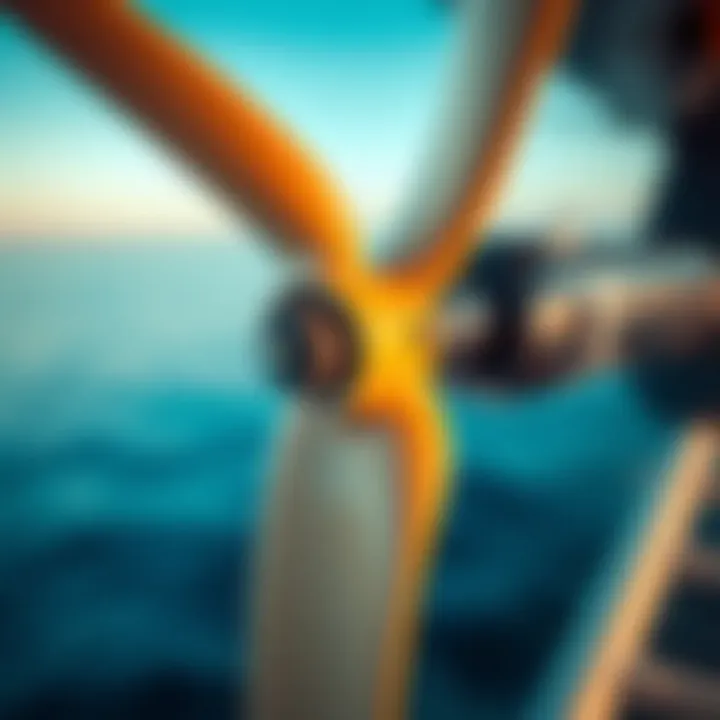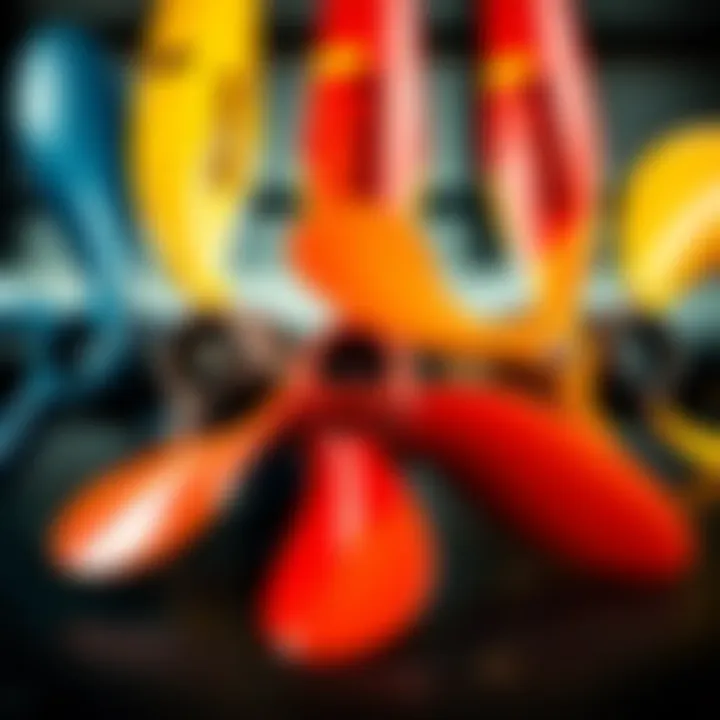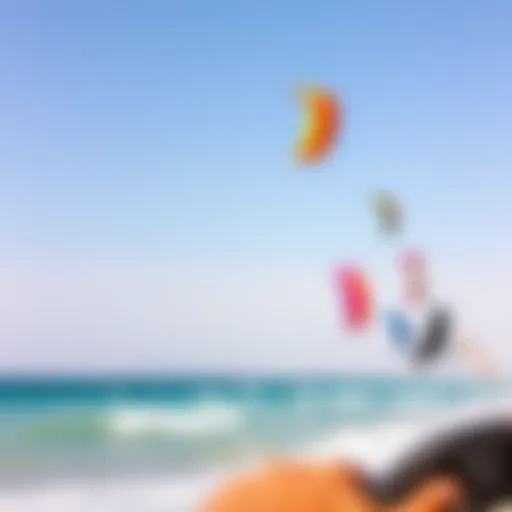Exploring Efoil Propellers: Design and Performance


Intro
Efoiling is rapidly gaining traction among water sports enthusiasts. At the heart of this exciting glide through the waves lies propellers; they play a pivotal role in determining performance and efficiency. Understanding efoil propellers can not only elevate one’s riding experience but also fine-tune the craft itself.
Propellers differ widely in design and size, and their functionalities can have major implications on speed, stability, and overall ride quality. The choice of propeller affects how well the efoil slices through water, impacting both efficiency and responsiveness.
This exploration delves into the types of efoil propellers available, the materials that compose them, and the innovations shaping the future of propeller technology. Furthermore, it sheds light on the significance of proper maintenance and how to select the right propeller for various efoiling setups.
By the end of this article, both newcomers and seasoned riders will walk away with the knowledge to not just ride but also optimize their efoil setups for the ultimate experience. Insert your favorite ride songs, and let’s dive into the waves of propeller wisdom.
Gear Selection
When it comes to efoiling, selecting the right gear is not merely a matter of preference; it’s about enhancing your entire riding experience. With various components all influencing performance, the choice of propeller certainly stands out as a key player in this mix.
Types of Propellers
Efoil propellers typically come in a variety of shapes and sizes, each designed for specific riding styles and conditions. Here are some common types:
- High Aspect Ratio Propellers: These are often chosen for their efficiency in calm waters, allowing smooth cruising with minimal drag.
- Low Aspect Ratio Propellers: Ideal for more turbulent conditions, these propellers can endure rugged waters and provide a stable ride, making them popular among thrill-seekers.
- Multi-Blade Propellers: Featuring multiple blades, these propellers offer unique advantages in terms of acceleration and grip in the water. They can be great for those who desire quick take-offs.
Choosing the Right Propeller
After selecting the appropriate type, the next step is to ensure compatibility with your efoil setup. This means considering the following aspects:
- Diameter and Pitch: Larger diameters can enhance speed but may compromise maneuverability. Conversely, smaller diameters might improve control at lower speeds but limit maximum velocity.
- Material: The choice often comes down to durability versus weight. Carbon fiber provides lightweight strength, while aluminum offers a more substantial feel but may come at the cost of extra weight.
Maintenance Practices
Efoil propellers, like any mechanical component, require maintenance to ensure long-lasting performance. Regular checks for wear and tear can save riders from unexpected mishaps. Basic practices include:
- Rinsing after use to prevent saltwater corrosion
- Inspecting for nicks or dents that could affect performance
- Regularly tightening screws and bolts that secure the propeller
By paying attention to these maintenance routines, riders can extend the life of their propellers and ensure a smooth ride.
"The right propeller is like a well-tailored suit; it needs to fit the individual perfectly for the best results."
Culmination
Understanding efoil propellers is integral to maximizing the efoiling experience. From types and materials to personalized gear selection and maintenance practices, being informed can make a world of difference. Riders will find that the right propeller not only enhances their performance but can also elevate the overall thrill of gliding over water.
For further reading on related topics, explore resources like Britannica, Wikipedia, or Reddit. Dive into forums, communities, and discussions for insights that can fine-tune your efoiling journey.
Prologue to Efoil Technology
Electric hydrofoiling, commonly known as efoiling, represents a fascinating evolution in water sports, combining cutting-edge technology with thrilling experiences on the water. Understanding efoil technology is vital for anyone looking to delve into this innovative sport. The technology not only enhances the riding experience but also reshapes the way enthusiasts engage with watercraft. Whether you are a seasoned kiteboarder or a newcomer eager to learn, knowing the underlying mechanics and benefits of efoils can significantly improve your journey.
Defining Efoils
At its core, an efoil is a specially designed surfboard equipped with a hydrofoil and an electric propulsion system. This technology allows surfers to glide above the water's surface, offering an utterly unique sensation compared to traditional surfing or kiteboarding.
- Hydrofoil structure: The hydrofoil permits the board to elevate off the water at speed, drastically reducing drag and enhancing speed and efficiency.
- Electric propulsion: The onboard electric motor, often powered by a rechargeable battery, lets riders control their speed, making the experience accessible, even in relatively calm conditions.
Despite its simplicity in definition, the beauty of efoils lies in their hybrid nature, merging elements of surfing, sailing, and even snowboarding, providing a fresh thrill that captivates adventurers.
The Rise of Electric Hydrofoiling
In recent years, efoiling has rapidly gained traction globally, appealing to a wide variety of enthusiasts. This surge stems from multiple factors:
- Accessibility: Efoiling has made it possible for many to experience the thrill of surf without the need for waves or wind. As long as there's enough water beneath, anyone can experience the joy of gliding effortlessly.
- Technological Advancements: Improvements in battery technology and motor efficiency mean that efoils can provide longer rides without compromising performance. Riders can now enjoy extended sessions with less downtime for charging.
- Environmental Awareness: As more individuals become conscious of environmental issues, electric options for water sports present a cleaner alternative to gas-powered motors. With advancements focused on electric power, riders can experience exciting water maneuvers while reducing their carbon footprint.
"Efoiling isn’t just a trend; it’s the forefront of a new way to enjoy water sports without the hefty environmental cost."
As the efoil community grows, so does the wealth of information available about its technology, performance, and potential. Enthusiasts now have opportunities to connect, share experiences, and collaborate on innovations, effectively building a robust culture around this exhilarating pursuit. Understanding the foundational elements of efoil systems is crucial for all involved, ensuring they maximize their investment while enjoying this groundbreaking sport.
Principles of Propeller Functionality
Understanding the principles underlying propeller functionality is paramount when exploring efoils. This knowledge not only enhances rider performance but also tweaks the overall efficiency of the efoil system. Simply put, the right propeller can differentiate between a ride that feels like gliding on air and one that resembles rolling through molasses.
How Propellers Propel
At its core, a propeller works by converting rotary motion into thrust. The blades of a propeller cut through the water, creating pressure differences above and below the blades. This pressure imbalance generates lift, much like the wings of an airplane do, pushing the efoil forward. Each blade's shape and angle play significant roles in how effectively it can move water.
To break it down further:


- Blade Pitch: The angle of the propeller blades affects how much water is displaced. A higher pitch can increase speed but may require more power to turn.
- Blade Length: Longer blades can capture more water, generating more thrust; however, they also create more drag.
- Number of Blades: Typically, efoils have between two to four blades. More blades can mean more thrust but can also increase drag, a delicate balance that must be struck depending on usage.
"A well-designed propeller is like a finely tuned instrument; it harmonizes the relationship between thrust and drag, ensuring optimal performance."
In the world of efoiling, every element of propeller functionality is a serious consideration for riders looking to maximize their experience. Whether zipping across calm waters or navigating through a gusty wind, the propulsion capabilities of the efoil's propeller can significantly influence both the ride quality and efficiency.
Hydrodynamics and Efoil Performance
The theory of hydrodynamics becomes an indispensable resource when considering how propellers function within the aquatic environment. Simply put, hydrodynamics studies how forces interact with and travel through fluids. When it comes to efoil performance, understanding these principles is like having a secret weapon in your arsenal.
Several factors influence hydrodynamic performance:
- Water Density: Freshwater and saltwater have different densities, affecting how the propeller interacts with each. This necessitates adjustments in propeller design and material to adapt to the medium.
- Flow Patterns: The movement of water around the propeller blades dictates how effectively propellers create thrust. Turbulent flow can be detrimental, while laminar flow leads to smooth propulsion.
- Drag Coefficient: Every propeller incurs drag, but the goal is to limit this as much as possible. A well-designed propeller minimizes resistance against water, optimizing performance and energy consumption.
When these hydrodynamic principles merge seamlessly with propeller design, the result is enhanced agility, control, and stability on the water. Fast and responsive turns can transform ordinary rides into exhilarating experiences, while a deeper understanding of water interactions elevates a rider's confidence and ability.
Knowing the principles of propeller functionality, including how various factors come into play, equips riders with the knowledge to make informed decisions about their efoil setup. This insight leads not only to a better ride but also opens up possibilities for tweaking performance and experiencing the sport in new ways.
Types of Efoil Propellers
When it comes to efoil technology, understanding the types of propellers is crucial, as they directly influence performance, maneuverability, and overall riding experience. Selecting the right propeller can make all the difference between a thrilling ride and an underwhelming one. Here, we look into the different types of efoil propellers, emphasizing what sets them apart.
Radial Propellers
Radial propellers, characterized by blades that extend outward from a central hub, are prevalent in various marine applications. Their design facilitates high thrust levels at lower rotational speeds, which can be beneficial for efoils needing substantial lift without excessive energy loss. The curved blades enhance efficiency in water displacement, thus optimizing energy consumption. One of the key benefits of radial propellers is their ability to perform well in choppy waters, providing riders with a more stable and controlled experience.
Radial propellers are generally easier to manufacture compared to other types, as they can be designed using simpler molds and materials. However, their effectiveness diminishes at high speeds where axial propellers might take the lead in performance. Riders looking for a mix of stability and speed in moderate conditions should consider radial options.
Axial Propellers
On the other hand, axial propellers boast a design that allows water to pass through the blades along the axis of rotation. This type of propeller tends to be narrower and longer, providing greater efficiency at higher speeds. Axial propellers generate less drag, making them the go-to choice for riders who want top speed and swift maneuvers.
One major advantage of axial propellers is their capability to maintain thrust across varying speeds. This means that during a fast descent or tight turns, they can still produce ample thrust, ensuring that the efoil remains agile and responsive. However, it is worth noting that in lower speeds, axial propellers may not generate as much lift as radial ones, which could lead to difficulties for novice riders.
Advancements in Propeller Geometry
As efoiling technology advances, so does the geometry of propellers. The innovations in propeller design now include various shapes and configurations that enhance performance metrics. For example, the use of swept blades helps with airflow management around the tips, decreasing drag and noise. Additionally, some models now incorporate adjustable pitch, allowing riders to customize the angle of the blades based on their riding style and conditions.
Emerging computational techniques have transformed the way manufacturers approach propeller geometry. By utilizing computational fluid dynamics, engineers simulate different conditions to test and refine their designs efficiently. This has led to breakthroughs in achieving the perfect balance of speed, efficiency, and control.
“The devil is in the details. Innovating propeller design can mean the difference between a good ride and a phenomenal one.”
These innovations hold great promise for the future of efoils, as they cater to the diverse range of preferences among riders. As efoil enthusiasts continue to demand more speed and efficiency, manufacturers are stepping up to the plate, transforming how we experience this exhilarating sport.
In summary, the types of efoil propellers each offer distinct benefits and drawbacks. Radial propellers excel in stability, while axial propellers lead in high-speed performance. Lastly, advancements in propeller geometry foster ongoing improvement in both efficiency and rider experience. Understanding these facets is essential for any rider looking to elevate their efoiling journey.
Materials and Construction
The materials and construction techniques used in efoil propellers play a crucial role in their performance, durability, and overall efficiency. Understanding these elements can greatly affect the riding experience, influencing everything from thrust generation to maneuverability in various water conditions. Selecting the right materials is not just a technical requirement, but it's essential for ensuring the longevity and functionality of the propeller, thus enhancing the enjoyment during efoiling sessions.
Composite Materials
In the realm of efoil propellers, composite materials such as fiberglass and carbon fiber have carved out a strong reputation.
- Lightweight yet Strong: One of the key benefits of using composite materials is their remarkable strength-to-weight ratio. A propeller made from carbon fiber, for instance, can maintain structural integrity without the heft, allowing for more sustained acceleration and better performance, especially in competitive setups.
- Corrosion Resistance: Another significant advantage is their resistance to corrosion. With efoils often subjected to saltwater conditions, opting for materials that can withstand such environments reduces maintenance worries. Fiberglass, in particular, is renowned for surviving these harsh realities without significant wear, contributing to an extended lifespan.
However, composite materials often come with considerations that need attention:
- Cost: The initial investment in high-grade composites can be higher than that of traditional materials. Riders may find themselves torn between budget constraints and performance aspirations.
- Impact Sensitivity: While composites are resilient, they can suffer from damage upon severe impact. Being mindful of hitting hard objects while riding can go a long way in maintaining the propeller's optimal condition.
Metallic Components
On the other side of the spectrum, metallic components, particularly aluminum and stainless steel, also have their own sets of merits and challenges.
- Structural Robustness: Metals are often noted for their durability and robustness. An aluminum propeller, for instance, is less likely to flex under pressure compared to some composites, making it suitable for rugged use. Additionally, metals can handle varying aquatic conditions, particularly in heavy waves or adverse weather.
- Cost-Effectiveness: Compared to their composite counterparts, metallic options tend to be more affordable. This can be enticing for budget-conscious efoilers who still want reliable performance without breaking the bank.
Nevertheless, employing metallic components carries risks that riders should be aware of:
- Weight Penalty: A significant drawback of using metals is the extra weight they contribute. This can affect the overall buoyancy and agility of the efoil, making it more challenging to maneuver swiftly.
- Corrosion Potential: Although stainless steel is relatively resistant to corrosion, it isn’t entirely impervious. Riders should be vigilant about regular cleaning and maintenance, especially after using their efoils in saltwater, to extend the lifespan of metallic propellers.
Choosing the correct material for efoil propellers can feel like a balancing act between performance and practicality.
Performance Metrics for Efoil Propellers


When it comes to efoil propellers, performance metrics play a pivotal role in understanding how well a specific setup will function in real-world conditions. These metrics help in evaluating how efficiently the propeller converts the rotational energy from the power unit into forward motion. For enthusiasts and instructors alike, grasping key performance metrics ensures that riders can make informed decisions tailored to their riding styles and environmental conditions. Let's break this down further into more specific elements:
Thrust and Efficiency
Thrust is basically the force that propels the efoil forward. A propeller with higher thrust doesn't automatically guarantee a better ride, but when paired with solid efficiency, it can translate power into speed and performance. This metric is especially crucial during water sports like efoiling, where optimal thrust leads to quicker acceleration. Efficiency, on the other hand, indicates how well the propeller utilizes power to generate thrust. In practical terms, a combination of high thrust and efficiency ensures that a rider experiences maximized performance without draining the battery prematurely.
"Finding the right balance between thrust and efficiency can make all the difference in your efoiling experience; more power doesn’t always mean better performance."
Speed and Maneuverability
Speed is a natural calling for any thrill-seeker, and it’s no exception in the world of efoils. The design of the propeller contributes directly to how fast an efoil can travel across the water. However, it’s not just about going fast; maneuverability is equally important. The ability to make sharp turns or glide fluidly through the water enhances the overall enjoyment of the ride. Certain propeller designs allow for better control at higher speeds, thus improving how a rider navigates challenges like waves or other obstacles. Riders should always prioritize a propeller suited for their personal preference, whether that’s speed-focused for racing or agility-focused for tricks and stunts.
Noise Levels and Vibration
Noise levels and vibrations can greatly affect the quality of the ride. A smooth, quiet operation is often preferred, especially for those who want a serene experience on the water. High noise levels not only detract from the enjoyment but can also indicate inefficiency in the propeller design. Vibrations on the other hand can lead to discomfort and even mechanical issues over time. For those wanting the best experience, testing out different propellers might reveal how varying designs produce differing noise and vibration profiles. A propeller that balances these factors contributes to a more pleasurable ride, allowing the focus to remain on the thrill of efoiling rather than the distractions presented by a raucous environment.
Understanding these performance metrics is essential, especially when considering different riding styles or planning for various conditions. Riders should not only look for statistical performance data but also consider personal preference and environment in these assessments to ensure optimal choice.
Selecting the Right Efoil Propeller
Choosing the right efoil propeller isn't just a matter of picking out a shiny new component; it’s the heartbeat of your ride. The propeller plays a critical role in how your efoil performs, impacting everything from speed to stability. Understanding how to match your equipment with your personal preferences can greatly enhance your riding experience.
Matching Propeller to Power Unit
First things first, the propeller needs to dance harmoniously with your power unit. This involves more than just ensuring they are compatible. You want to consider factors like the power output of your motor and the intended use of your efoil.
- Power Rating: Different propellers have designs tailored for specific power configurations. For instance, a high-output motor will generally require a larger propeller to harness the available thrust effectively.
- Throttle Response: Matching the propeller's design to your motor's response can create a balanced experience. If you’ve got a snappy motor that quickly ramps up, a stiffer propeller might be ideal. Conversely, a more forgiving propeller can help in smoothing out the bumps for a gentler ride.
- Propeller Size: Keep in mind that the pitch of the propeller also influences performance. A higher pitch translates to a faster ride but requires more power to spin effectively. It can make you feel like you’re soaring, provided your power unit is up to the task. The key here is a balanced relationship between power unit and propeller.
Personal Riding Style Considerations
Not all riders are cut from the same cloth, and personal riding style can dramatically affect your choice of propeller. This factor includes how you intend to use the efoil—whether you’re after speed, leisure, or tricks.
- Speed Demands: If your aim is to slice through the waves at top speed, you’ll want a propeller engineered for performance. Look for options that provide a stiff design with reduced drag, enabling a thrilling ride.
- Casual Cruising: For those who prefer leisurely rides, a more flexible propeller might be best. This kind can facilitate better lift at lower speeds, making your efoil experience more enjoyable without the need for constant throttle.
- Trick Riding: If airborne stunts are your jam, you’ll want a propeller that offers quick responsiveness. There is no real joy in trying to get airborne with a propeller that takes forever to get going. In this case, lightweight materials and agile designs are essential.
Each propeller type influences everything from how smoothly you glide above the water to how quickly you respond to environmental shifts. A thorough understanding of your riding style will ensure your propeller suits your approach, leading to a more harmonious relationship with your efoil.
"Matching the right propeller can make a world of difference in your efoiling experience. Tailor your equipment to your style for the best ride possible."
Whether you're powering through waves or carving dramatic turns, selecting the right efoil propeller is about maximizing potential and personal enjoyment. Taking the time to marry your power unit's specifications with your individual riding preferences will set you on a path toward mastery on the water.
Maintaining Your Efoil Propeller
Keeping your efoil propeller in good shape is not just good practice; it's essential for ensuring a safe and enjoyable ride. A well-maintained propeller can drastically affect overall performance and extend the life of your efoil setup. With efoiling gaining traction among water sports enthusiasts, understanding how to care for your propeller can significantly enhance your experience.
Routine Inspection Procedures
Routine inspections should become part of your efoiling rituals. Performing these checks helps in catching potential issues before they escalate into more significant problems. Here are some key steps you can follow:
- Visual Inspection: Start with a good, eye-level inspection of your propeller. Look for any noticeable damage such as cracks, nicks, or dents. Even minor damage can have a compounding negative effect on performance.
- Check for Debris: During your routine checks, ensure that no fishing lines, seaweed, or other debris are tangled in or around the propeller. Removing these can prevent wear and tear.
- Bolt and Nut Security: Inspect the screws and bolts for tightness. Loose fittings can lead to vibrations or, in the worst case, part failures while in the water.
- Lubrication: While it’s not always necessary, occasionally lubricating moving parts can prevent rust and ensure smoother operation. Use marine-grade lubricants designed for this purpose.
Keeping a logbook or checklist of these inspections could prove invaluable. Having a recorded history not only aids in maintenance but can also alert you to recurring issues that may need professional attention.
Identifying Wear and Tear
Over time, wear and tear are inevitable, especially in salty or harsh environments. Recognizing the signs of wear before they compromise performance can mean the difference between a smooth ride and a costly repair. Here’s what to look for:
- Surface Degradation: Pay close attention to the surface condition of the propeller. Signs of rust, pitting, or blistering can indicate a need for immediate action.
- Change in Performance: If you notice a decrease in thrust or an increase in noise levels, it may indicate that your propeller is not operating at peak efficiency. Such changes often signal a likely problem in the propeller’s integrity.
- Vibration During Use: An increase in vibration could be a symptom of imbalance caused by wear or damage. If you experience more vibrations than usual, it might be time to take a deeper look at your prop setup.
- Corrosion on Metal Components: If your propeller is of metal construction, keep an eye out for signs of corrosion or electrolysis. Such issues can lead to decreased performance and potential failures.
Ultimately, a proactive attitude toward maintenance can prolong the life of your efoil propeller. By taking regular care of your equipment, you not only enhance your ride quality but also ensure safety on the water.
"A stitch in time saves nine" – regular checks can catch small problems before they become big headaches.
For further details on maintenance strategies, you can visit Wikipedia.
Innovations in Efoil Propeller Design
Innovations in efoil propeller design are crucial in advancing the performance and efficiency of these electric hydrofoils. As riders seek improved experiences, manufacturers have turned to technology and creativity to push the boundaries of traditional propeller design. This comparatively new segment of watersports is rapidly evolving, raising the bar on what efoil propellers can achieve.
The importance of innovations in this space not only lies in raw performance but also in enhancing user experience while maintaining environmental responsibility. The integration of novel concepts can lead to significant benefits, such as reduced noise pollution, improved hydrodynamics, and better energy efficiency. Such advancements also address riders' concerns around maintenance, longevity of components, and overall performance in various water conditions.
Emerging Technologies
The realm of emerging technologies has a profound impact on the development of efoil propellers. With breakthroughs in materials science, innovations such as 3D printing and the use of lightweight composite materials enable more sophisticated designs. These advancements allow for more complex shapes that optimize water flow around the propeller, translating to better thrust and efficiency.


One notable enhancement is the use of bio-inspired designs, mimicking the natural forms of aquatic creatures. Such strategies have shown promise in increasing maneuverability and reducing drag. Additionally, adaptive propellers that can adjust their pitch and angle based on riding conditions are becoming more viable. These engineered solutions attempt to take the guesswork out of propeller selection, improving adaptability during ride performance.
Moreover, battery technology also plays a key role. More efficient batteries mean longer ride times and less need for frequent recharges, enhancing the overall riding experience.
Role of Computational Fluid Dynamics
Computational fluid dynamics (CFD) is a game changer in the field of efoil propeller design. It employs advanced algorithms and simulations to predict how different propeller shapes will perform in water. By analyzing the flow patterns around propeller blades, engineers can refine designs to ensure maximum thrust with minimal resistance.
CFD allows designers to test iterations without the need for physical prototypes, thereby saving time and resources. This means faster development cycles and the ability to explore unconventional propeller geometries which might previously have been too risky or costly to test in real-world environments. It leads to an unprecedented level of customization in efoil propellers, enabling manufacturers to cater to the specific needs of different riders. For example, a rider focused on speed may require different propeller characteristics than a rider prioritizing stability in choppy waters.
"Using computational fluid dynamics is like having a crystal ball that shows us how a design will perform before it even hits the water."
In the context of efoils, where water conditions can shift dramatically, the precision provided by CFD can be likened to giving a skilled musician a finely tuned instrument. The synergy of technology and creativity ushers in a new wave of possibilities, helping enthusiasts and professionals alike to unlock an unparalleled riding experience.
In sum, the innovations in efoil propeller design are a testament to the industry's commitment to enhancing not just performance, but also the environmental sustainability of the sport. By leveraging emerging technologies and powerful simulations, the future of efoils looks promising, offering riders an experience that is both exhilarating and responsible.
Impact of Propeller Design on Riding Experience
In the domain of efoiling, the propeller is not merely a mechanical component; it is a critical player that influences not just performance but the overall experience of riding on water. The way a propeller is designed can dictate everything from how quickly a rider can accelerate to how stable their ride feels in challenging conditions. Thus, understanding the impact of propeller design becomes essential for anyone looking to enhance their enjoyment of the sport.
When we talk about acceleration and top speed, the shape and size of the propeller can make all the difference. A well-designed propeller harnesses the energy from the motor efficiently, allowing for quicker takeoffs and more swift transitions through flat waters and waves alike. For example, wider blades might be ideal for a rider who prioritizes grunt and pulling power, especially when navigating choppy areas. Conversely, a more streamlined design can optimize for speed, slicing through water with ease.
"Choosing the right propeller is like finding the right pair of shoes; it can either make or break your trajectory on the water."
Acceleration and Top Speed
Acceleration refers to how fast a rider can reach their desired speed after starting from a standstill. This is not merely dictated by power output but intricately tied to the propeller's geometry. For instance, a propeller with a larger diameter can deliver increased thrust, ideal for riders who want to leap forward quickly. But that’s not all; the pitch of the blades—essentially how angled they are—also plays a pivotal role. A propeller with a higher pitch allows for faster speeds but may sacrifice initial acceleration. Riders often find themselves making nuanced choices between these attributes, depending on their preferred style. **Some quick considerations:
- Larger diameter for better thrust
- Higher pitch for increased speed**
Yet, while speed can be thrilling, it is equally crucial to balance it with stability.
Stability and Control in Varied Conditions
Now, let’s shift gears and examine stability. When conditions get dicey, be it through gusty winds or unpredictable currents, a well-designed propeller can mean the difference between a controlled experience and a chaotic one. Propellers that strike a balance between thrust and control are invaluable. A wider propeller can provide a more stable platform, helping to keep the board buoyant and offering better maneuverability.
Factors such as blade angle and surface area significantly contribute to stability. A propeller with a well-calibrated design can cut through the water efficiently, minimizing cavitation—which is an air bubble phenomenon that can jerk the ride and throw off balance. The blend of throttle response and control allows the rider to navigate through tough environments confidently, lending the rider a feeling of assurance.
To wrap up this section:
- A propeller's design impacts both acceleration and stability.
- Wider blades help with stability, while larger diameter offers thrust.
- Balance between speed and control is vital for an enjoyable ride.
Environmental Considerations in Efoiling
When diving into the world of efoiling, one must consider the environmental footprint of this exhilarating sport. Efoiling, while high-tech and thrilling, also faces scrutiny regarding its impact on marine ecosystems and noise pollution. The right approach can ensure that this activity remains sustainable, allowing enthusiasts to enjoy the water without harming it. Evaluating noise levels and energy consumption are two crucial elements to be aware of, as they can significantly influence both the rider's experience and the natural environment.
Noise Pollution Mitigation Strategies
Water sports often come with a symphony of sounds, but excessive noise generated by efoil propellers can disturb marine life and other water users. To tackle this issue, several mitigation strategies can be employed:
- Selecting Quiet Propeller Designs: Choosing propellers that are engineered for reduced noise can make a big difference. These designs often feature special geometries that cut through water more smoothly, minimizing cavitation and the associated sound.
- Using Lower RPMs: Operating at optimal RPMs, rather than maxing out the power, can lessen the noise produced without sacrificing too much performance. This also promotes energy efficiency, which benefits the overall riding experience.
- Regular Maintenance: Keeping the propeller clean and in good shape ensures it operates silently. Wear and tear can create noise that wasn't present when the propeller was new, so regular inspections are key.
- Rider Awareness: Being mindful of where and when to ride is essential. Steering clear of sensitive marine habitats, especially during breeding seasons, encompasses responsible efoiling behavior.
By adopting these strategies, efoil riders not only enhance their own experience but also contribute positively to the aquatic ecosystems they enjoy.
Energy Efficiency Improvements
The push for energy efficiency in efoiling is not just about conserving battery life; it also resonates on a broader ecological level. With rising concerns about energy consumption in various sports, particularly those using electric motors, efoils have the potential to lead the way in sustainability. Here are some points to ponder:
- Optimizing Propeller Designs: Advances in propeller technology often lead to designs that maximize thrust while minimizing drag. For instance, blades that can adjust their pitch based on riding conditions can significantly improve propulsion efficiency, requiring less power from the battery.
- Battery Technology Advancements: Modern lithium batteries not only store more energy for longer outings but also discharge that energy more efficiently. Keeping an eye on current innovations in battery tech can guide riders to select the most effective pack, ultimately reducing wasted energy.
- Engaging in Eco-friendly Practices: As efoiling grows in popularity, promoting eco-friendly practices in the community is vital. Encouraging group outings to reduce the number of rides can lessen the cumulative energy impact on the environment.
- Education and Awareness: Riders should be informed about energy-efficient riding techniques. Simple practices like avoiding hard accelerations can lead to more efficient use of battery power, contributing to a lower overall energy footprint.
Culmination: The Future of Efoil Propellers
As we stand at the crossroads of innovation and performance in the realm of efoiling, it becomes strikingly clear that the design and function of propellers play a pivotal role in shaping the future riding experiences. Understanding the trajectory of efoil propellers isn't just about technical specifications; it is a glimpse into the evolving relationship between rider and technology. The implications of the advancements we explore here touch riders regardless of skill level—from novices savoring their first glide to seasoned pros pushing the boundaries of what's possible on water.
Trends in Efoil Development
The development trajectory of efoils paints a dynamic picture. A growing trend is the push towards lighter and more durable materials. Carbon fiber and various advanced composites allow manufacturers to create propellers that not only enhance performance but also contribute significantly to weight reduction. Lighter props mean quicker acceleration and less drag, translating to a smoother ride on the water.
- Increased customization is another hallmark of current efoil trends. Riders are now able to tailor their setups with ease, selecting props that align with their personal preferences and riding styles. This trend is closely tied to technology in manufacturing, where 3D printing is becoming increasingly popular.
- Furthermore, there's a noticeable surge in eco-friendly innovations. Many manufacturers are looking to optimize energy efficiency, developing propellers that demand less power for the same thrust, ultimately reducing the environmental impact.
These trends point towards a future where efoiling becomes more personalized and environmentally sustainable. It’s essential to recognize the interplay between technology advancements and user experiences for a holistic understanding of what lies ahead.
Predicted Innovations in Propeller Technology
Looking into the crystal ball, anticipated innovations in propeller technology are set to redefine the landscape of efoiling. One major area of focus is adaptive propeller design. Imagine propellers that adjust their pitch or shape based on water conditions or rider input, optimizing for speed or stability as needed. This level of adaptability could not only enhance performance but also increase safety in unpredictable conditions.
Another exciting frontier is the potential integration of smart sensors into propellers. Picture propellers equipped with sensors that relay feedback on performance metrics directly to the rider. This could offer real-time insights into efficiency and handling, thus allowing riders to make informed adjustments, enhancing their overall experience.
- Bio-inspired designs also on the horizon show promise. By studying marine life, engineers are developing propellers that mimic the efficient movements of fish, potentially revolutionizing thrust and maneuverability. These designs could provide powerful propulsion while minimizing energy usage.
- Lastly, advances in computational fluid dynamics will likely lead to further insights into hydrodynamic designs, pushing the boundaries of what’s possible in propeller shape and function.
In summary, as we navigate the turbulent waters of evolving efoil technology, an understanding of propeller innovation and development trends offers invaluable insights. The changes on the horizon present not just advancements in sport but a reflection of the synergetic relationship between technology and rider satisfaction.















